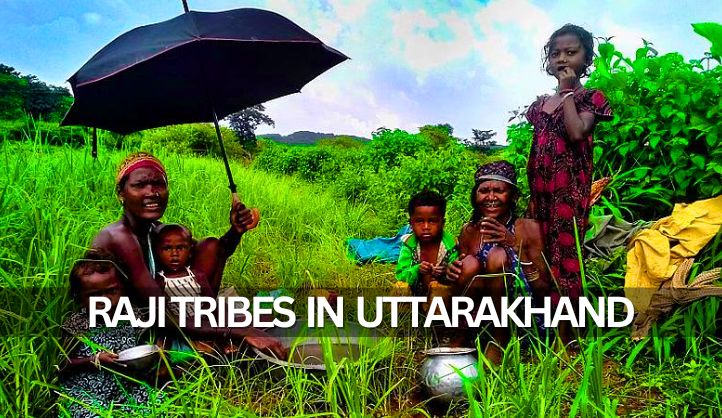The Raji tribes are one of the lesser-known yet fascinating indigenous communities of India. With a history and culture deeply intertwined with the natural beauty of the region, the Raji people offer a unique glimpse into traditional Himalayan life. This blog explores the history, culture, lifestyle, and current challenges faced by the Raji tribes in Uttarakhand.
Origins and History
The Raji tribes, also known as the Rajis or Rajis, are an indigenous community residing primarily in the remote areas of Uttarakhand’s Pithoragarh district. Historically, they have been considered one of the oldest communities in the region, with roots that trace back centuries. The Rajis are believed to have migrated from the western parts of the Indian subcontinent, settling in the hilly areas of Uttarakhand due to their adaptability to the mountainous terrain.
Cultural Heritage
Language and Identity
The Raji tribes speak a dialect known as Raji or Raji Boli, which is distinct from the languages spoken in the surrounding areas. This dialect reflects their unique cultural identity and has been passed down through generations. Despite the influence of neighboring languages, the Rajis have managed to preserve their linguistic heritage.
Traditional Customs and Festivals
The Rajis celebrate various traditional festivals and ceremonies that highlight their rich cultural heritage. One of the prominent festivals is Harela, a celebration of the harvest season, where the community comes together to express gratitude to nature and seek blessings for prosperity. Basant Panchami and Dashain are also significant festivals for the Rajis, marked by traditional rituals, music, and dance.
The Raji community has a strong connection to nature, with many of their customs and rituals centered around agricultural practices, forest resources, and seasonal changes. Their deep reverence for nature is reflected in their traditional beliefs and practices.
Lifestyle and Occupation
Traditional Livelihood
The traditional livelihood of the Raji tribes revolves around agriculture, with rice, maize, and barley being the staple crops. They practice shifting cultivation, also known as jhum cultivation, which involves clearing a piece of forest land for farming and moving to a new area once the soil’s fertility diminishes.
In addition to agriculture, the Rajis are skilled in various handicrafts, including weaving and basketry. These traditional crafts are not only a source of income but also play a significant role in preserving their cultural heritage.
Housing and Architecture
The traditional homes of the Rajis are constructed using locally available materials like wood, stone, and mud. These houses are designed to withstand the harsh climatic conditions of the region and are typically built on elevated platforms to protect against floods and wild animals.
Social Structure and Community Life
Social Organization
The Raji tribe has a well-defined social structure, with elders playing a crucial role in decision-making and conflict resolution. The community is organized into clans, each with its customs and traditions. Panchayats (local councils) are responsible for maintaining social harmony and addressing issues within the community.
Education and Modernization
In recent years, there has been a growing emphasis on education and modernization within the Raji community. While traditional practices are still prevalent, younger generations are increasingly pursuing education and employment opportunities outside their traditional occupations. This shift is gradually transforming the socio-economic landscape of the Raji tribes.
Challenges and Conservation Efforts
Socio-Economic Challenges
The Raji tribes face several challenges, including poverty, limited access to healthcare and education, and environmental degradation. The shift from traditional to modern lifestyles has also led to a loss of traditional knowledge and skills.
Conservation and Development
Efforts are being made to address these challenges through various conservation and development programs. Government initiatives and non-governmental organizations (NGOs) are working to improve the living conditions of the Rajis by providing better access to education, healthcare, and sustainable livelihoods.
Other Tribes of Uttarakhand
Uttarakhand, with its diverse geography and rich cultural tapestry, is home to several indigenous tribes, each with unique traditions and ways of life. Here’s an overview of some of the prominent tribes of Uttarakhand:
1. Tharu Tribe
Location: Primarily in the Terai region of Uttarakhand.
Culture and Traditions:
- The Tharu are known for their rich folklore, dance, and music.
- They practice agriculture, particularly the cultivation of rice, and are skilled in traditional crafts.
- Festivals like Holi and Tihar are celebrated with distinctive rituals and performances.Lifestyle:
- Traditionally, the Tharu live in small, self-sustaining villages with homes made from mud and thatch.
- They have a close relationship with the forest and wildlife, often using traditional knowledge for medicinal and agricultural purposes.
2. Buksas Tribe
Location: Predominantly in the Terai and Bhabar regions of Uttarakhand.
Culture and Traditions:
- The Buksa tribe has a vibrant cultural heritage with traditional music, dance, and rituals.
- They are known for their colorful attire and intricate beadwork.Lifestyle:
- The Buksa people practice agriculture, focusing on crops like rice, maize, and vegetables.
- Their traditional homes are made from locally available materials, designed to suit the region’s climate.
3. Rathia Tribe
Location: Found in parts of the Pithoragarh district.
Culture and Traditions:
- The Rathia tribe is known for their unique traditional customs, including folk dances and songs.
- Their festivals often include community feasts and ceremonies that reflect their deep connection to nature.Lifestyle:
- The Rathia people engage in agriculture and animal husbandry.
- Their homes are typically made from locally sourced materials, reflecting their integration with the environment.
4. Jaunsari Tribe
Location: Primarily in the Jaunsar-Bawar region of the Dehradun district.
Culture and Traditions:
- The Jaunsari tribe has a rich tradition of folk music, dance, and storytelling.
- They celebrate festivals such as Magh Mela with traditional ceremonies and community gatherings.
Lifestyle:
- The Jaunsari people practice subsistence agriculture, growing crops like barley, maize, and potatoes.
- Their homes are designed to withstand the cold climate of the region and are often built using stone and wood.
Conclusion
The Raji tribes of Uttarakhand are a vibrant and resilient community with a rich cultural heritage that reflects the unique landscape of the Himalayas. Despite facing various challenges, the Rajis continue to uphold their traditions and contribute to the diverse cultural tapestry of Uttarakhand. By understanding and supporting the Raji tribes, we can help preserve their invaluable heritage and promote sustainable development in the region.
Whether you’re a cultural enthusiast, a traveler seeking off-the-beaten-path experiences, or someone interested in indigenous communities, exploring the lives of the Raji tribes offers a profound and enriching experience that connects you with the heart of Uttarakhand’s mountainous heritage.
FAQs About the Raji Tribes of Uttarakhand
1. Who are the Raji tribes?
The Raji tribes, also known as the Rajis or Rajis, are an indigenous community residing primarily in the Pithoragarh district of Uttarakhand, India. They are known for their unique cultural heritage, traditional practices, and deep connection with the natural environment.
2. What is the origin of the Raji tribes?
The Raji tribes are believed to have migrated from the western parts of the Indian subcontinent centuries ago. They settled in the mountainous regions of Uttarakhand, where they adapted to the local environment and developed their distinct cultural identity.
3. What language do the Raji tribes speak?
The Raji tribes speak a dialect known as Raji or Raji Boli. This dialect is unique to their community and reflects their cultural heritage. Despite the influence of surrounding languages, the Rajis have managed to preserve their linguistic traditions.
4. What are some traditional festivals celebrated by the Raji tribes?
The Raji tribes celebrate several traditional festivals, including:
Harela: A harvest festival where the community expresses gratitude to nature and seeks blessings for prosperity.
Basant Panchami: A festival dedicated to the goddess Saraswati, marking the arrival of spring.
Dashain: A major Hindu festival celebrated with traditional rituals, music, and dance.
5. What is the traditional livelihood of the Raji tribes?
Traditionally, the Raji tribes rely on agriculture as their primary livelihood. They practice shifting cultivation, also known as jhum cultivation, growing crops such as rice, maize, and barley. They are also skilled in handicrafts like weaving and basketry.





